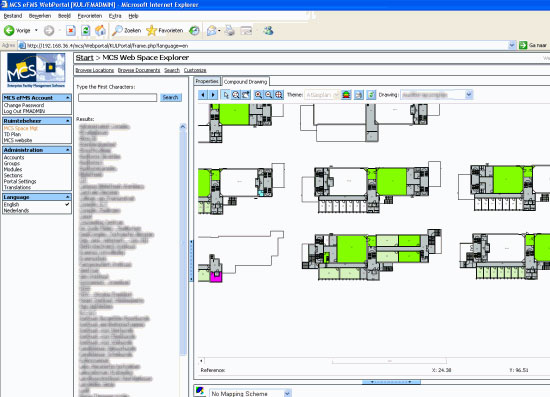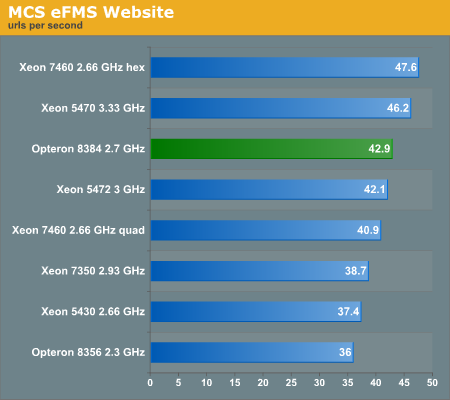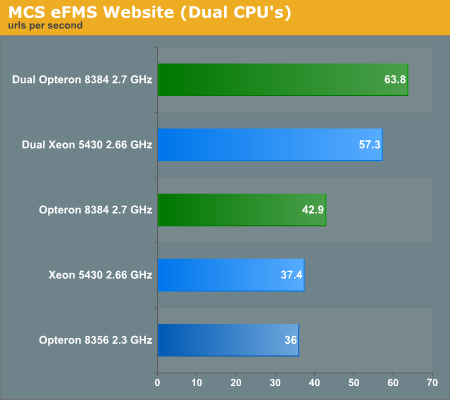The Best Server CPUs Compared, Part 1
by Johan De Gelas on December 22, 2008 10:00 PM EST- Posted in
- IT Computing
MCS eFMS (Windows 2003 32-bit EE)
One of the very interesting and processing intensive applications that we encountered was the modular MCS Enterprise Facility Management Software (MCS eFMS), developed by MCS. The objective of eFMS is to integrate the management of space usage (buildings), assets and equipment (such as furniture, beamers etc.), cabling infrastructure, and other areas while keeping track of costs. MCS eFMS stores all information in a central Oracle database.

MCS eFMS integrates space management, room reservations and much more.
What makes the application interesting to us as IT researchers is the integration of three key technologies: A web-based frontend that integrates CAD drawings and gets its information from a rather complex, ERP-like Oracle database; building overview trees of all rooms available and their reservations in a certain building; and drilling down using the CAD drawing to get more detail: MCS eFMS is one of the most demanding web applications we have encountered so far. MCS eFMS uses the following software:
- Microsoft IIS 6.0 (Windows 2003 Server Standard Edition R2)
- PHP 4.4.0
- FastCGI
- Oracle 9.2
MCS eFMS is used daily by large international companies such as Siemens, Ernst & Young, and Startpeople, which makes testing this application even more attractive. We used the specially developed APUS (Application Unique Stress-testing) software, developed by our own lab to analyze the logs we got from MCS and turn these logs into a real stress test. The result is a benchmark that closely models the way users access the web servers around the world. First we test with only one CPU.

This is the real thing. No team of compiler writers have been losing their sleep to rearrange a few pieces of assembler so that the out of order scheduling can happen as smoothly as possible. Like all business logic code, it is a huge pile of complex layers, one upon the other. It is almost impossible to add some extremely clever "benchmark only boosts" in this one.
Intel takes the top spots, but it needs a 120W 3.3GHz CPU to overpower the newest AMD CPU. Typically there about 6 to 10 frontend servers (the eFMS website) for one backend (the Oracle server), so while the backend server is all about the highest CPU and I/O performance, the frontend is best served with "midrange power" CPUs.

The Opteron improves its performance by 49% and the Xeon by 53% if you add a second quad-core. This benchmark has an error margin of about 3%, so it seems that both CPUs scale more or less the same.










29 Comments
View All Comments
zpdixon42 - Wednesday, December 24, 2008 - link
DDR2-1067: oh, you are right. I was thinking of Deneb.Yes performance/dollar depends on the application you are running, so what I am suggesting more precisely is that you compute some perf/$ metric for every benchmark you run. And even if the CPU price is less negligible compared to the rest of the server components, it is always interesting to look both at absolute perf and perf/$ rather than just absolute perf.
denka - Wednesday, December 24, 2008 - link
32-bit? 1.5Gb SGA? This is really ridiculous. Your tests should be bottlenecked by IOJohanAnandtech - Wednesday, December 24, 2008 - link
I forgot to mention that the database created is slightly larger than 1 GB. And we wouldn't be able to get >80% CPU load if we were bottlenecked by I/Odenka - Wednesday, December 24, 2008 - link
You are right, this is a smallish database. By the way, when you report CPU utilization, would you take IOWait separate from CPU used? If taken together (which was not clear) it is possible to get 100% CPU utilization out of which 90% will be IOWait :)denka - Wednesday, December 24, 2008 - link
Not to be negative: excellent article, by the waymkruer - Tuesday, December 23, 2008 - link
If/When AMD does release the Istanbul (k10.5 6-core), The Nehalem will again be relegated to second place for most HPC.Exar3342 - Wednesday, December 24, 2008 - link
Yeah, by that time we will have 8-core Sandy Bridge 32nm chips from Intel...Amiga500 - Tuesday, December 23, 2008 - link
I guess the key battleground will be Shanghai versus Nehalem in the virtualised server space...AMD need their optimisations to shine through.
Its entirely understandable that you could not conduct virtualisation tests on the Nehalem platform, but unfortunate from the point of view that it may decide whether Shanghai is a success or failure over its life as a whole. As always, time is the great enemy! :-)
JohanAnandtech - Tuesday, December 23, 2008 - link
"you could not conduct virtualisation tests on the Nehalem platform"Yes. At the moment we have only 3 GB of DDR-3 1066. So that would make pretty poor Virtualization benches indeed.
"unfortunate from the point of view that it may decide whether Shanghai is a success or failure"
Personally, I think this might still be one of Shanghai strong points. Virtualization is about memory bandwidth, cache size and TLBs. Shanghai can't beat Nehalem's BW, but when it comes to TLB size it can make up a bit.
VooDooAddict - Tuesday, December 23, 2008 - link
With the VMWare benchmark, it is really just a measure of the CPU / Memory. Unless you are running applications with very small datasets where everything fits into RAM, the primary bottlenck I've run into is the storage system. I find it much better to focus your hardware funds on the storage system and use the company standard hardware for server platform.This isn't to say the bench isn't useful. Just wanted to let people know not to base your VMWare buildout soley on those numbers.